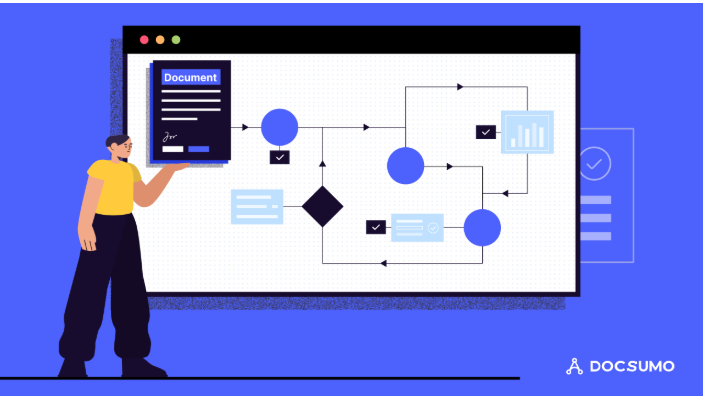Workflow automation services are a game-changer for businesses looking to scale, reduce operational costs, and improve efficiency. With the right systems in place, automation helps businesses handle repetitive tasks, streamline processes, and enhance overall productivity. However, the key to successful automation lies in choosing the right partner to guide you through the process. A good automation partner will not only implement the best tools for your needs but also help you identify bottlenecks, align processes, and ensure that your systems are working together seamlessly.
But choosing the wrong partner can lead to wasted time, increased costs, and disappointing results. It’s crucial to make an informed decision and understand what you need in a partner. The right partner should understand your business’s goals and help you achieve them through the best automation solutions available.
In this article, we will walk you through a step-by-step guide on how to evaluate automation partners. This includes understanding your specific business needs, identifying the right tools and features, and assessing the costs and benefits. Whether you’re new to automation or seeking a partner to upgrade your current systems, this guide will help you make an informed decision, ensuring that your business is on the path to successful growth and improvement.
Let’s get started!
Understanding Your Business Needs
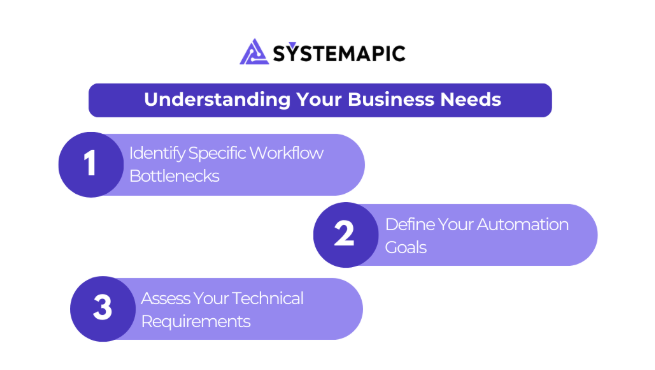
Before choosing an automation partner, it’s crucial to first understand your business needs. Without a clear understanding of what your business requires, you may end up with a solution that doesn’t fully address your challenges or help you reach your goals. Here’s how to get started:
- Identify Specific Workflow Bottlenecks
Start by identifying the specific areas in your business that could benefit from automation. These might include:
- Manual processes like data entry, invoicing, or customer follow-ups.
- Slow approval processes that delay projects or payments.
- Repetitive customer service tasks that can be handled by AI chatbots.
By pinpointing these areas, you can narrow down the type of automation solutions you need. Consider what tasks are taking up the most time, and ask yourself if those tasks could be automated.
- Define Your Automation Goals
Once you’ve identified the bottlenecks, you need to set clear objectives for what you want to achieve with automation. Ask yourself:
- Do you want to reduce costs by streamlining operations?
- Are you trying to increase productivity by eliminating manual work?
- Do you need to scale without adding extra employees?
Having specific goals will help you choose the right partner who can tailor their solutions to your business needs. Be sure to define measurable outcomes so you can track the success of your automation efforts.
- Assess Your Technical Requirements
Consider your business’s existing technology stack. Think about the systems you’re currently using, such as CRMs, ERPs, or project management tools. Make sure the automation tools you choose will integrate smoothly with these systems. A good partner will have experience with your tech stack and can customize automation solutions that fit seamlessly.
By understanding your needs, goals, and technical requirements, you’ll have a much clearer picture of the type of partner that can help your business scale efficiently.
What to Look for in an Automation Partner
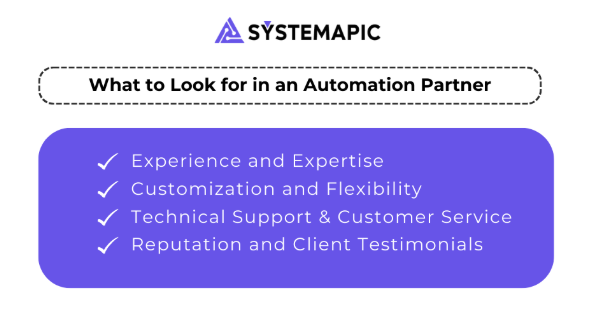
When selecting the right workflow automation partner for your business, there are several key qualities to look for. A strong partnership can make or break the success of your automation efforts. Here are the most important factors to consider:
Experience and Expertise
The ideal automation partner should have experience and expertise in your industry. Automation solutions are not “one-size-fits-all,” so it’s essential to choose a partner who understands the specific challenges of your business. Look for a partner that:
- Has a proven track record in implementing automation solutions for businesses of your size and industry.
- Understands your pain points and can offer customized solutions.
- Can show case studies or testimonials from other clients with similar needs.
Experience matters because it ensures the partner can anticipate challenges and find effective solutions, saving you time and potential headaches.
Customization and Flexibility
Your business is unique, and the automation solutions you need should reflect that. A great partner will offer customizable solutions that fit your specific workflows, systems, and goals. Look for a partner who can:
- Tailor automation tools to your business, not just offer off-the-shelf products.
- Be flexible enough to adjust as your business evolves and your needs change over time.
- Offer scalable solutions that can grow with your business.
Scalability is especially important if you plan to expand. You want to ensure that the automation tools you implement can accommodate increased workloads without requiring a major overhaul.
Technical Support and Customer Service
Automation isn’t a one-time setup—it requires ongoing attention and support. You need a partner who can provide consistent technical support both during and after the implementation phase. Look for a partner that:
- Offers 24/7 customer support or at least dedicated hours based on your needs.
- Has a clear process for troubleshooting issues quickly and effectively.
- Provides training for your team to ensure everyone understands how to use the automation tools effectively.
Good customer service ensures that your automation systems continue to run smoothly and that your team feels confident in using them.
Reputation and Client Testimonials
A solid reputation is a clear indicator of reliability. Before making your final decision, check:
- The partner’s reviews and testimonials from previous clients.
- Look for case studies that demonstrate their success in implementing automation in businesses similar to yours.
- Consider the partner’s reputation in the industry. Have they been recognized or awarded for their work?
Reputation matters because it shows the partner’s ability to deliver consistent, high-quality results.
Evaluating the Automation Tools and Platforms
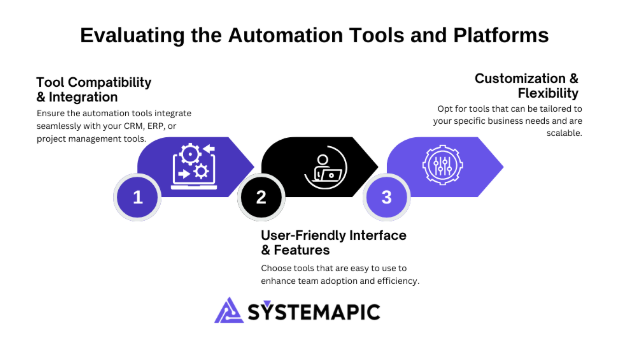
When choosing a workflow automation partner, it’s important to evaluate the tools and platforms they offer. The right tools will ensure that your business runs smoothly, integrates well with your existing systems, and scales as needed. Here are the key factors to consider when assessing automation tools:
Tool Compatibility and Integration
One of the first things to look at is how well the automation tools integrate with your existing systems. If your company already uses software like a CRM, ERP, or project management tool, it’s essential that the automation platform can connect with those systems. Otherwise, you’ll face integration issues that could cause data silos, duplicate entries, or manual workarounds.
Ask the partner:
- Does the tool integrate with your current tech stack (CRM, email marketing, accounting systems)?
- Can the platform sync data in real-time across different systems to prevent discrepancies?
- Is the tool flexible enough to work with any software you might use in the future?
User-Friendly Interface and Features
Automation tools are only as effective as they are easy to use. If the system is too complicated, it will slow down your team rather than speeding up operations. Look for platforms that offer:
- Intuitive interfaces that require minimal training.
- Drag-and-drop features that allow easy workflow creation without a developer.
- Customizable templates to help you get started quickly with standard workflows.
- Advanced reporting and analytics that can help you track performance and measure ROI.
The more user-friendly the system is, the more likely your team will adopt and benefit from it.
Customization and Flexibility
Every business is unique, and the automation tools you choose should reflect that. Look for a partner that offers solutions that are:
- Easily customizable to fit your specific workflows, whether it’s for invoicing, lead management, or HR tasks.
- Scalable so that as your business grows, the tools can grow with you.
- Able to handle multi-departmental automation for more complex business needs.
A flexible platform means that as your business evolves, the automation solution can be adjusted without a complete overhaul.
Cost vs. Value: What’s the Right Budget?
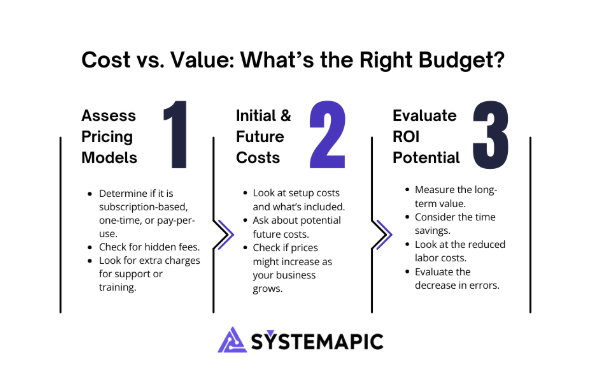
When considering a workflow automation partner, it’s crucial to evaluate both cost and value. While automation tools often come with an initial investment, the right choice can save your business money in the long run by reducing operational costs, improving efficiency, and increasing productivity. Here’s how to assess the costs:
Assess Pricing Models
Start by understanding the pricing structure offered by the automation partner. Automation solutions typically come in several pricing models:
- Subscription-based pricing (monthly or annually).
- One-time fee for the software and setup.
- Pay-per-use models, where you only pay for the features you use.
Consider the initial setup costs and what’s included in the package. Be sure to ask about:
- Hidden fees for additional features or users.
- Support and training costs—do they charge extra for onboarding or ongoing support?
- Future costs—will prices increase as your business grows, or are you locked into a contract?
Evaluate ROI Potential
When it comes to automation, it’s essential to think about long-term value rather than just upfront costs. Here are a few factors to consider when calculating ROI:
- Time saved by eliminating manual processes.
- Reduced labor costs from automating repetitive tasks.
- Increased accuracy, leading to fewer costly mistakes and less rework.
- Improved customer satisfaction, resulting in better retention and revenue.
You want to choose a partner who offers a clear ROI. An automation solution that costs more initially may pay for itself within a few months if it dramatically reduces operational inefficiencies.
The Decision-Making Framework
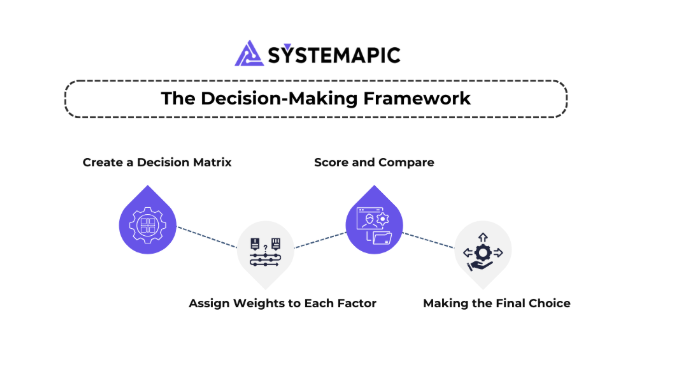
Choosing the right workflow automation partner can be a difficult decision with so many factors to consider. A solid decision-making framework can help you objectively compare and rank potential partners based on what’s most important for your business. Here’s how to build a framework to guide your decision:
Create a Decision Matrix
A decision matrix is a simple tool that helps you compare multiple partners based on important factors. Start by creating a list of the criteria that matter most for your business. Here’s a sample list to consider:
- Experience and expertise in your industry.
- Customization and flexibility of the automation solution.
- Tool compatibility with your current systems.
- Pricing structure and overall value.
- Customer support and service during and after implementation.
- Client feedback and case studies demonstrating success.
Assign Weights to Each Factor
Not all factors are created equal. Some criteria might be more important to your business than others. For example, price might be less important than customer support or customization. Assign weights to each factor to reflect their importance.
- Example:
- Experience and expertise (weight: 30%)
- Customization and flexibility (weight: 25%)
- Pricing (weight: 20%)
- Customer support (weight: 15%)
- Client feedback (weight: 10%)
Score and Compare
Once you’ve assigned weights, score each automation partner based on how well they meet each criterion. Multiply the scores by the weights for each factor to get a total score. The partner with the highest total score will be the one that best fits your business needs.
Making the Final Choice
After scoring, review the results and consider:
- Which partner aligns most closely with your business goals?
- Does one partner offer a solution that fits your budget and needs better?
- Which partner has the best long-term potential to grow with your business?
By using a decision matrix, you can evaluate your options objectively and choose the partner that offers the best value for your business.
Final Thoughts
Choosing the right workflow automation partner is a critical decision for the future of your business. The right partner will help you streamline operations, reduce costs, and scale effectively. However, it’s essential to take the time to evaluate your options carefully.
Here’s a quick recap of the key steps in choosing the best automation partner for your business:
- Understand your business needs and goals. Start by identifying bottlenecks and defining what you want to achieve with automation.
- Evaluate potential partners based on experience, customization capabilities, and reputation. Ensure they have the expertise and flexibility to meet your unique needs.
- Assess the automation tools they offer, checking for compatibility with your current systems and ensuring they provide the features necessary to support your business growth.
- Balance cost and value by looking beyond initial expenses and considering the long-term ROI.
- Use a decision-making framework to objectively compare your options based on what matters most for your business.
By following these steps, you can confidently select the right automation partner who will help your business achieve its goals, optimize workflows, and drive sustainable growth.
At Systemapic, we specialize in helping businesses implement tailored automation solutions including airtable system development that meet their unique needs. If you’re ready to explore how workflow automation can streamline your operations and improve efficiency, let’s talk!







